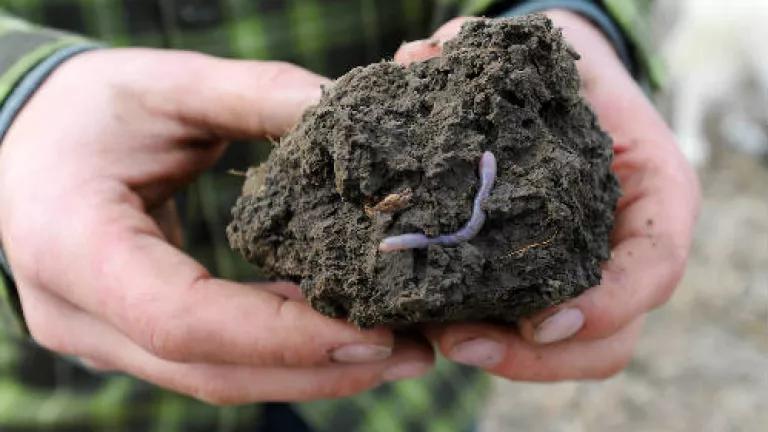Case Studies: Cutting Waste & Boosting Food Donation
Up to forty percent of food in America is wasted and it costs our economy roughly $218 billion each year. When food goes to waste, so does everything that goes into growing, storing and transporting that food: water, energy, labor, agricultural chemicals, money and more. In addition, most of that food ends up in landfills, where it generates methane, a greenhouse gas that is up to 86 times more powerful than carbon dioxide. At the same time, nearly 41 million people in the United States lack consistent access to adequate food.
To help find solutions to these challenges, today NRDC—with support from The Rockefeller Foundation—is releasing two new reports that showcase the role cities can play in addressing the problem. One study offers critical data about the amounts, sources, and types of food going to waste in three U.S. cities (Denver, Nashville & NYC), and the other study reveals opportunities—particularly for food businesses and institutions—for redirecting surplus foods to those in need in those cities.
Alongside these reports, we’re also releasing a package of case studies that offer examples of innovators—from government agencies to nonprofit food banks and private companies—around the country that are experimenting with solutions to find new ways to tackle these problems. These case studies highlight a range of innovation, policy and strategies that continue to grow and evolve throughout the country, with attention on those that prevent food from being wasted, connect surplus food with people in need, and encourage composting. Many of them also have added social benefits, such as job creation and career training.
These case studies show that city and regional governments, business leaders, non-profit organizations, philanthropic stakeholders and citizens, all have an important role to play in catalyzing innovation to reduce the amount of food going to waste.
You can find the full case studies here, and an overview follows:
VERMONT: State Universal Recycling Law bans food from landfills.
The state of Vermont passed comprehensive legislation in 2012 that bans the landfilling of food. The law clearly identifies the meaningful alternatives that exist for uneaten food and food scraps and encourages Vermont residents and businesses to stop wasting food that instead can help families in need, feed animals on local farms, or create rich soil and renewable energy products. This law, phased in over a period of years, requires that food, alongside other organic waste and recyclables, be diverted from landfill disposal by 2020. As a result of this law, the amount and quality of food donated to food bankshas increased dramatically, landfill disposal has decreased, and recycling and composting have increased. From 2015 to 2016, food donations have grown by nearly 40 percent. And from 2014 to 2015, landfill disposal decreased 5 percent statewide while recycling and composting increased 2 percent. Some towns have seen even stronger results. For example, the town of Vernon saw its trash volume cut in half and its recycling increase by 50 percent.
MASSACHUSETTS: Daily Table is rescuing food and creating better alternatives for low-income families.
Daily Table is a nonprofit grocery store based in Dorchester, Massachusetts, that uses excess food from growers, manufacturers, distributors and supermarkets to provide low-income families with access to affordable, healthy food. Founded in 2015, it is designed around customer experience and community needs. When planning the launch of this new business model, Daily Table worked with experts to develop nutrition guidelines that inform decisions regarding the food that the store accepts as donation and sells. It also established a Community Advisory Council to ensure local input and hires from within the local community. Informed by this stakeholder engagement, Daily Table recognized that many of its customers need meals that can be prepared quickly. So, it decided to offer both ready-to-eat balanced meals as well a selection of produce, bread, dairy, and other healthy grocery items. At Daily Table, a family can get the recommended amount of nutrients within its Supplemental Nutrition Assistance Program (SNAP) allotment and within the time constraints of a typical working low-income family. By covering a significant portion of its operating costs through grocery sales, Daily Table aims to break even consistently, enabling long-term sustainability for the store. Building on the continued progress of the Dorchester store, Daily Table will open a second store in Roxbury, Massachusetts in November 2017. And the Daily Table model is also designed to facilitate further replication.
WASHINGTON, DC: DC Central Kitchen’s cost-effective food rescue strategy creates jobs for at-risk individuals.
DCCK’s mission is to “use food as a tool to strengthen bodies, empower minds, and build communities,” with a focus on helping people build a path out of poverty and incarceration. It started out in 1989 by collecting surplus food from events and training at-risk adults to prepare meals to donate to homeless shelters and other social services nonprofits. Since then, it has expanded to include additional social enterprises, such as a catering business that hires graduates from DCCK’s culinary training program and gives them a chance to begin careers in food services; Campus Kitchens, which uses on-campus kitchen space, rescues food from college cafeterias, trains students to prepare and deliver meals, and works with the surrounding community to identify opportunities for lasting impact; and Healthy School Food, a program that provides healthy meals to local schools. In 2016, DCCK’s food service-related revenues covered more than half of its operating costs, with the remaining half covered by philanthropic support. In the same year, DCCK rescued 680,987 pounds of food, prepared approximately 1.8 million meals, graduated 91 culinary students, and achieved a job placement rate of 88 percent. In addition, its approach has been replicated in other communities, expanding the impact of this model.
SAN FRANCISCO: Keeping food out of landfills through composting.
San Francisco has a long history of leadership in reducing waste. In 1996, it became the first city in the nation to establish a large-scale food composting program. The city achieved the statewide goal of 50 percent landfill diversion in 2000. In 2002, San Francisco expanded its commitment with a goal of 75 percent diversion by 2010 and zero waste by 2020. In 2009, the city implemented a mandatory recycling and composting policy for residents and businesses. By 2011, the city exceeded its 2010 goal with a 78 percent diversion rate. To achieve these results, San Francisco phased in legislation over time, developed financial incentives for households to compost and recycle, and invested in extensive outreach and marketing. It established citywide collection of food scraps and yard trimmings for composting to advance zero waste goals. The San Francisco Department of the Environment and the city’s Department of Public Works partnered with the city’s waste hauler, Recology, on a suite of strategies for building the city’s composting and zero waste programs. As a result of these efforts, since 2012, San Francisco has diverted more than 80 percent of all discarded waste from disposal.
PHILADELPHIA: Drexel University’s Food Lab working with partners to match surplus groceries with the city’s food donation needs.
Drexel Food Lab, a research group of faculty and students from Drexel University’s Culinary Arts and Food Science department, partnered with a local grocery store chain, Brown’s Super Stores, to study its most commonly unsold food items. In addition, Drexel collaborated with local shelters to understand their needs for donated food. Informed by this research, the Drexel Food Lab developed practical resources that were relevant to the shelters’ needs, such as simple, low-cost recipes for repurposing the most commonly donated produce and bakery items into value-added food products, such as veggie chips, jams, granola bars, and smoothie bases, and tested these recipes at local shelters. By understanding both what items were most commonly wasted at grocery stores and what food products were needed by shelters, Drexel was able to hone strategies to maximize the value and nutritional benefit of available foods. To expand the scale and impact of this project, Drexel also mapped out a replicable and profitable business model for repurposing excess supermarket food that could be implemented by food rescue organizations as a revenue generator, by community shelters and would also support local jobs and entrepreneurs across the United States.
CALIFORNIA: Waste Not Orange County Coalition is connecting people in need to food sources by building partnerships.
Waste Not OC is a public-private partnership that brings together a coalition that includes the food industry, public health and food safety officials, food banks, private organizations and charities to facilitate the donation and distribution of wholesome surplus food to people in need. The coalition uses a multipronged approach that includes: creating tools to facilitate food donations and educate the community; pursuing innovative partnerships to overcome transportation challenges for donated food; and identifying and connecting food-insecure individuals to food sources. Among other strategies, the coalition has sought to bridge the gap between the health department and food-related businesses, helping to turn Orange County health inspectors into champions for food donation, while also educating businesses on how to safely donate food. Since the coalition’s inception in 2012, they have partnered with more than 200 agencies and pantries and more than 400 businesses, food distributors, health care agency employees, and volunteers. The strength and breadth of those partnerships is beginning to pay off, and food donation in Orange County is expanding rapidly. In the first half of 2017 alone, Waste Not OC recovered 3,000 tons of surplus food, which amounts to approximately 5 million meals for food-insecure members of the community, a significant increase since 2016.
TENNESSEE: Second Harvest Food Bank’s creative solution for rescuing surplus tomatoes.
Second Harvest Food Bank of Middle Tennessee, one of the largest food banks in the United States, has a mission to provide food to those in need and work toward solving hunger issues. Second Harvest has long sought ways to reduce the cost of acquiring food while also increasing the amount of fresh produce it distributes. An opportunity arose in 2015 when FreshPoint, a national produce distributor, offered to donate 10,000 pounds of fresh tomatoes every week. By investing in in-house capacity to process these surplus tomatoes into a shelf-stable spaghetti sauce, Second Harvest is able to provide a product that is low in sodium, sugar, and fat, and high in vitamin C, giving families access to a high-quality, nutritious food year-round. As a result, Second Harvest is now one of the first food banks in the country to find a way to capture and redistribute millions of pounds of fresh produce through a large-scale food preservation system.
NATIONWIDE: Bon Appétit cuts food service costs and waste with imperfectly delicious produce.
In 2014, Bon Appétit teamed up with its parent company, Compass Group USA, the largest food-service company in the United States, and its extensive supplier network to evaluate opportunities to prevent waste across the supply chain and roll out the Imperfectly Delicious Produce (IDP) program state by state. The IDP purchasing program rescues flavorful but cosmetically imperfect produce and underused parts of fruits and vegetables from farms and distributors. IDP works with suppliers to identify appropriate products and trains produce processors, distributors and farmers about Bon Appétit’s purchasing standards. Bon Appétit chefs then incorporate these off-size or misshapen ingredients into their recipes. Bon Appétit was the first major food-service provider to establish a formal purchasing program in partnership with its distributors and major suppliers to use imperfect produce. The program started with successful pilots in California, Pennsylvania, and Washington state. As of February 2017, Bon Appétit has launched IDP in 30 states, while also drawing on Compass Group’s broader network of suppliers to have an even greater impact. In just a few years, Bon Appétit has already saved more than 2 million pounds and more than 50 different varieties of produce from going to waste.



